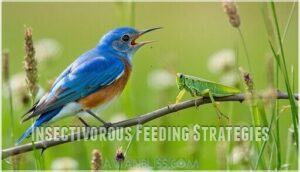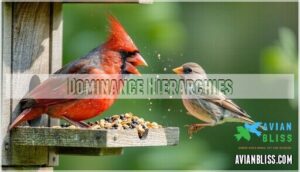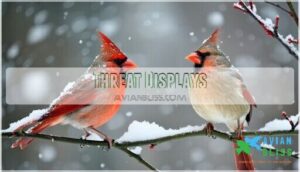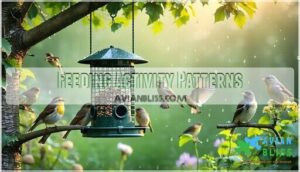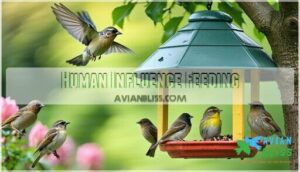This site is supported by our readers. We may earn a commission, at no cost to you, if you purchase through links.

Some birds, like pigeons, peck around on the ground, while hawks swoop mid-air to grab prey with incredible precision. Waterbirds, such as herons, patiently stalk their meals in shallow water, and nectar-loving hummingbirds flit between flowers like tiny acrobats.
Other birds specialize in seeds, fruits, or insects, depending on their beak shape and habitat. You’ll also notice how feeding isn’t just about eating—it involves competition, cooperation, and even quirky social interactions.
Keep an eye out, and you’ll learn there’s much more to this daily ritual.
Table Of Contents
- Key Takeaways
- Bird Feeding Patterns
- Feeding Behavior Types
- Social Interactions Feeding
- Feeding Activity Patterns
- Human Influence Feeding
- Frequently Asked Questions (FAQs)
- What is the feeding behavior of birds?
- Why do birds suddenly abandon feeders?
- Do birds like feeders high or low?
- What type of feeding behavior does a bird have?
- What factors affect a bird’s appetite and feeding behavior?
- Why do birds eat a lot?
- How do you identify birds by their behavior?
- Why does my pet bird bounce when he eats a bird feeder?
- What is bird behavior?
- What is the 5 7 9 rule for bird feeders?
- Conclusion
Key Takeaways
- You’ll notice birds follow distinct feeding patterns tied to energy needs, with three daily peaks: morning for replenishment after night, midday despite competition, and evening to prepare for nighttime survival.
- When you observe birds feeding, you’re witnessing social interactions that reveal fascinating hierarchies—larger or more assertive birds dominate prime feeding spots while smaller birds use appeasement behaviors like crouching or wing folding to avoid conflict.
- You can support healthy bird populations by providing fresh food, maintaining clean feeders, planting native species that align with natural food preferences, and establishing consistent feeding schedules.
- You’ll see diverse feeding strategies among birds based on their diet specialization—from ground-feeding granivores with seed-cracking bills to aerial insect hunters with remarkable agility, water-based fishers with specialized diving techniques, and nectar-sipping species with straw-like tongues.
Bird Feeding Patterns
Birds have fascinating feeding patterns shaped by their habitats, diets, and survival needs.
Whether they’re pecking at seeds on the ground or snatching insects mid-air, their behaviors reveal incredible adaptability.
Birds showcase incredible adaptability, thriving in diverse habitats with unique feeding strategies and behaviors that reveal nature’s creativity in action.
Ground Feeding Behaviors
Why do birds love ground feeding? It mimics their natural foraging techniques, letting them scratch through soil composition for seeds and insects.
Species like sparrows and robins thrive on this bird feeding behavior, balancing seed preferences with insect consumption.
Open spaces help with predator avoidance, while their bird behavior patterns contribute to pest control and seed dispersal—nature’s multitaskers at work!
Birds can be attracted using a specialized feeding platform.
Aerial Feeding Strategies
While ground feeding focuses on seeds and insects below, aerial feeding showcases incredible bird agility and precision.
Species like swallows and swifts master aerial hunting, using flight patterns to snatch insects mid-air.
These feeding techniques rely on foraging strategies that exploit specific altitudes, and watching their swift insect capture feels like witnessing nature’s acrobats perfecting their craft in the sky, which is a testament to their incredible bird agility.
Water-Based Feeding Techniques
While aerial feeders showcase agility, water-based feeding techniques highlight adaptability.
Water feeders embody nature’s adaptability, turning streams and ponds into thriving ecosystems of inventive bird foraging techniques.
Birds like ducks excel at surface feeding, skimming for insects or aquatic vegetation.
Others, such as pelicans, use diving techniques to catch fish, embodying piscivorous feeding ecology.
Flamingos, with their iconic filter feeding, sieve tiny organisms from water.
Proper diets may require specialized duck products.
These specialized methods underscore the fascinating diversity in bird feeding behavior across aquatic and marine environments, showcasing fascinating diversity.
Herbivorous Feeding Patterns
While water-based feeders dive or skim, herbivorous birds stick to plants.
Their avian diet showcases unique dietary preferences, from nectar consumption by hummingbirds to grass grazing by geese, it’s nature’s buffet, and each bird has a favorite dish.
- Hummingbirds sipping nectar
- Parrots munching seeds
- Geese grazing grass
- Fruit-eating toucans
- Leaf-digesting hoatzins
Some specialize in seed dispersal, while others nibble fruits or master leaf digestion.
Carnivorous Feeding Habits
While herbivores nibble on plants, carnivores take feeding to a whole new level.
Raptor hunting showcases sharp talons and keen eyesight, while piscivore techniques involve swift dives for fish.
Insectivore diets focus on bugs, and scavenger roles clean up leftovers.
Some species, like gulls, even show cannibalism.
These bird feeding behaviors highlight fascinating prey selection and feeding adaptations.
Carnivorous birds, like eagles, rely on sharp beaks and talons to hunt their prey.
| Feeding Type | Example Birds | Key Behavior |
|---|---|---|
| Raptor Hunting | Eagles, Hawks | Precision strikes |
| Piscivore | Kingfishers, Pelicans | Diving for fish |
| Scavenger Roles | Vultures, Crows | Consuming carrion |
These feeding behaviors are a testament to the diversity of birds and their unique adaptations to their environments.
The variety of feeding strategies, from raptor hunting to scavenging, demonstrates the complexity of bird behavior.
Feeding Behavior Types
Birds have mastered a variety of feeding behaviors, each suited to their diet and environment. From seed-crushing granivores to nectar-sipping specialists, their techniques reveal fascinating adaptations.
Granivorous Feeding Patterns
Granivorous birds, like sparrows and finches, thrive on seeds, showcasing fascinating bird feeding behavior.
Their bill morphology, often short and conical, is perfect for cracking tough shells. Food preference shifts with seasonal variation, as available seeds change.
Efficient digestion helps extract nutrients, while clever foraging strategies guarantee survival. Watching their bird foraging habits reveals the intricate balance of bird diets in nature, and highlights the importance of efficient digestion.
Piscivorous Feeding Behaviors
Switching from seeds to seafood, piscivorous birds showcase fascinating feeding patterns.
These skilled hunters rely on specialized bill morphology and diving techniques to capture fish, their primary food source.
- Diving Techniques: Gannets plunge dramatically into water for prey.
- Fish Selection: Cormorants prefer trout, while pelicans herd fish.
- Habitat Impact: Overfishing by birds affects ecosystems and conservation status.
Insectivorous Feeding Strategies
After piscivorous birds, insectivorous species showcase impressive insect capture techniques. Whether snapping mid-air or foraging under leaves, their bird feeding behavior highlights agility and precision.
Digestive specializations help process tough exoskeletons, while seasonal diet shifts adapt to insect availability. Bluebirds thrive on a diet of protein-rich insects, making them excellent examples of this feeding strategy.
However, insecticide exposure threatens their food supply, emphasizing habitat conservation. Watching these birds hunt feels like nature’s acrobatics in action!
Nectivorous Feeding Habits
Nectivorous birds, like hummingbirds and sunbirds, thrive on nectar-rich diets, showcasing fascinating adaptations.
Their tongue morphology often resembles a tiny straw, perfect for extracting nectar. These birds play a key role in pollination syndromes, relying on floral specializations to meet their energy demands.
Key nectivorous feeding traits include:
- Long, slender bills.
- High-energy food sources.
- Rapid foraging movements.
- Seasonal diet composition shifts.
- Vibrant bird feeding behavior.
Frugivorous Feeding Patterns
Frugivorous birds thrive on fruits, showcasing fascinating bird feeding behavior.
Their diet composition varies with fruit availability and seasonal variation, influencing habitat impact.
Digestive adaptations allow efficient seed dispersal, benefiting ecosystems.
From tropical rainforests to urban gardens, frugivorous species adapt to diverse food sources.
Watching them snack on berries or figs can feel like nature’s version of a fruit buffet!
| Aspect | Details | Examples |
|---|---|---|
| Fruit Availability | Seasonal and regional differences | Berries in winter |
| Seed Dispersal | Aids plant reproduction | Figs, cherries |
| Digestive Adaptations | Specialized enzymes | Parrots, toucans |
| Habitat Impact | Shapes vegetation patterns | Rainforests, savannahs |
| Seasonal Variation | Changes in diet composition | Mangos in summer |
Social Interactions Feeding
When birds gather to eat, it’s not just about the food—it’s a dynamic display of social interactions.
From dominance battles to cooperative teamwork, their feeding behavior reveals fascinating hierarchies and strategies.
Dominance Hierarchies
Bird behavior at feeders often reflects dominance hierarchies shaped by social structures.
Larger birds or those with assertive temperaments dominate, forcing submissive behavior in smaller or younger individuals.
Feeder aggression impacts survival, as dominant birds access safer spots and better food.
Group advantages can shift dynamics, but feeder hierarchies remain a critical factor in energy balance and predator avoidance.
Displacement Behaviors
Feeder dominance often leads to displacement, where one bird avoids another to sidestep aggression.
You’ll notice spatial avoidance as smaller birds wait nearby or retreat entirely.
Submissive postures, like crouching or looking away, reduce conflict during resource competition.
This bird behavior keeps feeding patterns flowing, even if it means some species miss prime opportunities at the feeder.
Threat Displays
Aggression signals in birds often involve dramatic threat displays to assert dominance or deter rivals.
These displays include:
- Feather postures, like fluffing up to appear larger.
- Wing displays, such as fanning or swaying side-to-side.
- Vocalizations, ranging from sharp calls to intimidating clicks.
These behaviors aren’t just for show—they’re effective in predator defense and maintaining order in social interactions.
Appeasement Behaviors
Appeasement behaviors in birds are like waving a white flag—they signal “no harm.”
Submissive postures, like crouching behavior or wing folding, help avoid conflict.
These de-escalation signals are common in bird behavior studies and can diffuse bird aggression.
Observing these subtle moves sharpens your bird behavior observation skills, revealing how birds manage conflict avoidance with grace.
| Behavior | Description | Purpose |
|---|---|---|
| Crouching | Lowering body close to ground | Submissive posture |
| Wing Folding | Tucking wings tightly | De-escalation signal |
| Looking Away | Avoiding eye contact | Conflict avoidance |
The table outlines specific behaviors, including crouching and wing folding, which are essential for understanding bird behavior and promoting peaceful coexistence.
By recognizing these signals, one can better appreciate the intricate social dynamics of birds and their methods of maintaining harmony.
Cooperative Feeding
While appeasement keeps the peace, cooperative feeding shows teamwork in action. Birds like pelicans use herding to catch fish, while woodpeckers store food for lean times.
Some species even practice food dropping to access tough meals. These behaviors highlight fascinating social structures and tool use in bird feeding patterns, proving that foraging isn’t always a solo act.
Bird flocking behavior enhances survival chances.
- Pelican herding for fish
- Woodpecker storage of acorns
- Food dropping for tough meals
- Group foraging in songbirds
- Shared nest feeding in groove-billed anis
Feeding Activity Patterns
You’ll notice birds don’t eat randomly—they follow distinct patterns tied to energy needs, competition, and safety.
By understanding these feeding activity peaks, you can better appreciate how birds balance survival challenges throughout the day, which is closely related to their survival challenges.
Daily Feeding Peaks
Bird feeding patterns reveal three key peaks daily.
The morning feeding peak focuses on energy replenishment after the night, while the midday feeding peak stems from competition for resources.
The evening feeding peak aids in preparation for nighttime survival.
Predictability impacts access, often favoring dominant birds, while subordinates adjust their schedules.
| Feeding Peak | Purpose | Key Challenge |
|---|---|---|
| Morning | Energy replenishment | Limited resources |
| Midday | Competition | Dominance conflicts |
| Evening | Night preparation | Predation risk |
Energy Replenishment Strategies
To manage overnight energy loss, birds prioritize morning feeding, balancing energy needs with fat reserve accumulation.
Food predictability impacts feeding habits; reliable sources reduce urgency, while unpredictable ones heighten early-day foraging.
Starvation vs predation drives bird behavior feeding strategies, as energy requirements push birds to riskier times.
Offering high energy food like sunflower seeds can greatly aid in this process.
Effective bird energy management reflects their intricate feeding strategies and adaptability.
Predation Risk Avoidance
Predation risk shapes bird feeding patterns. To stay safe, birds use clever strategies like feeding in groups or choosing well-hidden spots.
They’re masters of timing, avoiding predators by eating during low-risk hours. Vigilance behavior, like constant scanning, keeps them alert.
Bird behavior studies at feeders reveal fascinating predator avoidance tactics, from camouflage techniques to temporal avoidance, ensuring survival.
- Safe Feeding Spots: Hidden or protected areas.
- Vigilance Behavior: Constant scanning for predators.
- Group Size Effects: Safety in numbers.
- Temporal Avoidance: Feeding during low-risk times.
Fat Reserve Management
Balancing predation tradeoffs and energy reserves is a daily juggling act for birds.
Winter survival hinges on food predictability, as fat reserves fuel long nights.
Dominance impact plays a role, with dominant birds snagging prime feeding times.
Understanding bird behavior patterns reveals how energy balance shapes bird feeding habits and body condition.
| Factor | Impact on Birds | Example Behavior | Seasonal Influence | Outcome |
|---|---|---|---|---|
| Energy Balance | Drives fat storage | Early morning feeding | Winter | Increased survival chances |
| Food Predictability | Guides fat reserves | Late-day feeding | Winter | Improved energy reserves |
| Predation Tradeoffs | Limits feeding times | Mid-day avoidance | Year-round | Reduced predation risk |
| Dominance Impact | Determines access | Subordinates wait | Year-round | Unequal energy reserves |
| Bird Body Condition | Reflects fat levels | Fluffing feathers | Winter | Insulation and energy use |
The table outlines the key factors influencing bird behavior, including energy balance, food predictability, predation tradeoffs, dominance impact, and bird body condition.
These factors interact to determine the outcome of bird behavior, such as increased survival chances, improved energy reserves, reduced predation risk, and unequal energy reserves.
Human Influence Feeding
When you feed birds, your choices can shape their behaviors and even their survival.
Providing fresh food, maintaining clean feeders, and encouraging natural foraging with native plants helps keep them healthy and independent.
Responsible Bird Feeding
Feeding birds responsibly means keeping feeder hygiene a priority to prevent food contamination and disease.
Stick to bird feeding guidelines by offering fresh, safe food and encouraging natural foraging.
Avoid overfeeding to limit dependence on bird feeders, as it disrupts bird behavior, think of it as habitat enrichment—helping birds thrive without turning them into backyard freeloaders, by promoting natural foraging and preventing food contamination.
Native Plant Provision
Instead of filling feeders, consider planting native plants to support natural foraging.
They align with bird food preferences, offering better bird nutrition while enhancing biodiversity support.
Thoughtful plant selection restores habitats, benefiting both birds and ecosystems.
Watching birds enjoy berries, seeds, or nectar from your garden reveals bird behavior in action—proof that habitat restoration fosters healthier ecosystems and happier birds.
Fresh Food Supply
Using fresh food is key to supporting healthy bird feeding habits.
Stale or moldy bird food poses contamination risks, affecting bird health. Regularly check and replace food to avoid spoilage.
Proper storage methods, like airtight containers, help retain nutrients and prevent food spoilage. Adjust supply frequency to match bird food habits and guarantee consistent food availability, promoting natural bird behavior patterns, which support overall healthy bird feeding habits.
Clean Feeder Maintenance
Preventing disease at bird feeders starts with regular cleaning. Use safe practices—scrub feeders with cleaning solutions like a diluted bleach mix.
Choose durable feeder material, such as metal or plastic, to resist wear. Frequency matters: clean weekly or more often during heavy use.
Proper hygiene requires a dedicated feeder cleaner. These bird feeding tips help reduce infectious diseases, keeping your feathered visitors healthy and your feeders inviting with proper hygiene.
Irregular Feeding Schedules
After clean feeders, let’s look at how irregular feeding schedules affect birds.
While some species show foraging flexibility, resource scarcity can lead to behavioral adaptations like energy conservation or dietary shifts.
- Set consistent feeding times.
- Avoid over-reliance on human food.
- Observe bird behavior patterns.
- Support natural foraging habits.
- Keep feeders stocked responsibly.
Frequently Asked Questions (FAQs)
What is the feeding behavior of birds?
Birds feed in fascinating ways, from diving into water for fish to cracking seeds with specialized bills.
You’ll see behaviors like hunting, foraging, and even teamwork, showcasing their adaptability and role in ecosystems.
Why do birds suddenly abandon feeders?
It’s like a favorite café running out of coffee—birds abandon feeders due to food changes, dirty feeders spreading disease, or nearby predators scaring them off.
Trust me, they’re picky regulars with survival instincts!
Do birds like feeders high or low?
Height preferences for feeders depend on the bird.
Finches like elevated spots, feeling safer from predators, while ground feeders like sparrows prefer low placements.
Mixing heights welcomes different species and keeps your backyard lively and attracts various birds with elevated spots.
What type of feeding behavior does a bird have?
Imagine a bird as nature’s gourmet—its feeding behavior depends on diet, habitat, and survival needs.
From ground foraging to aerial hunting or water diving, each bird adapts uniquely, blending instincts and environment into survival artistry.
What factors affect a bird’s appetite and feeding behavior?
Your feathered friends’ appetites are influenced by temperature, breeding season, food availability, competition, time of day, migration preparation, and health status.
Weather changes can dramatically affect how much they’ll eat at your backyard feeder, which is also influenced by breeding season.
Why do birds eat a lot?
Just as Olympic athletes need constant fuel, birds eat a lot because they’re high-energy machines with fast metabolisms.
You’ll notice they’re constantly refueling to maintain body heat and support their active lifestyles.
How do you identify birds by their behavior?
Watch for distinctive movements, feeding habits, flight patterns, and social behaviors.
You’ll notice birds have unique ways of foraging, interacting, and responding to their environment.
Their body language often reveals their species identity, which can be a key factor in understanding their social behaviors.
Why does my pet bird bounce when he eats a bird feeder?
Birds bounce while eating to better position food in their beaks and throats.
This playful prancing helps your pet process each seed or pellet, ensuring it’s properly swallowed before reaching for more morsels.
What is bird behavior?
Your feathered friends display bird behavior through instinctive actions like feeding, mating, and nesting.
It’s how they communicate, survive, and adapt to their environment – basically their natural way of living.
What is the 5 7 9 rule for bird feeders?
Like a fortress with precise measurements, the 5-7-9 rule keeps squirrels at bay.
You’ll need to place your feeder 5 feet off the ground, 7 feet from structures, and 9 feet below overhanging branches.
Conclusion
Remarkably, scientists have documented over 10,000 unique bird behavior feeding patterns across species worldwide.
By understanding these intricate feeding rituals, you’ll gain deeper appreciation for the complexity of avian life. Whether you’re observing backyard visitors or exotic species, these feeding behaviors reveal evolutionary adaptations perfected over millions of years.
Next time you watch birds eat, you’ll recognize the sophisticated strategies behind each peck, swoop, and dive—nature’s masterclass in survival through specialized bird behavior feeding patterns.




